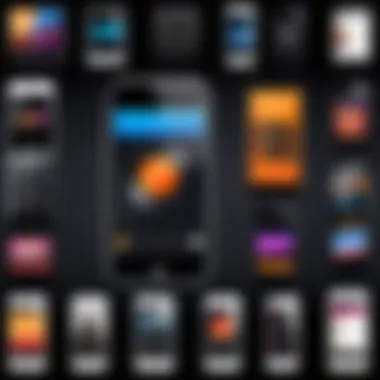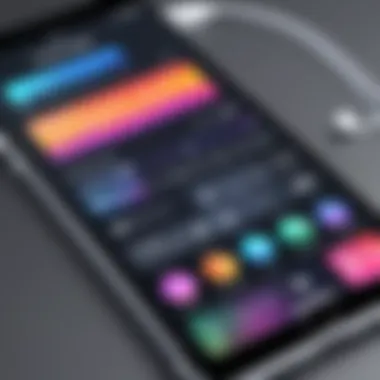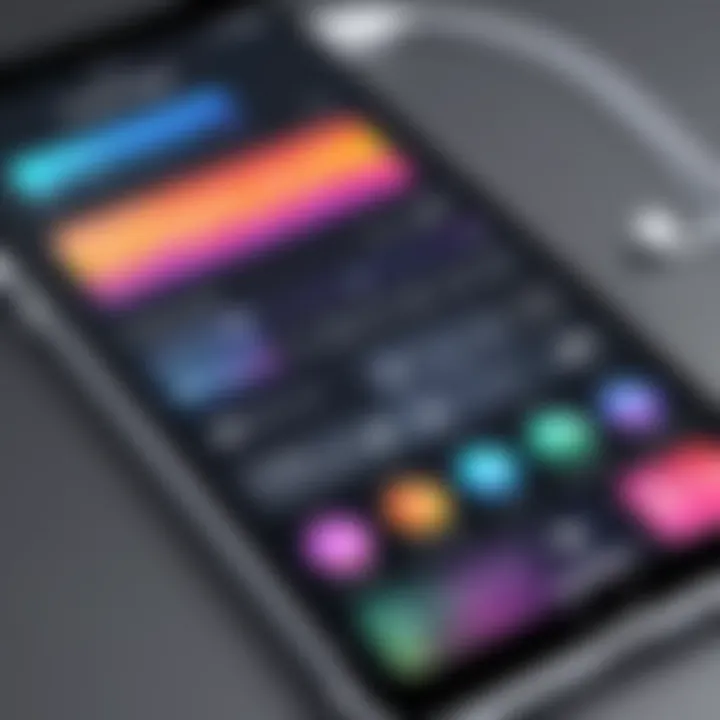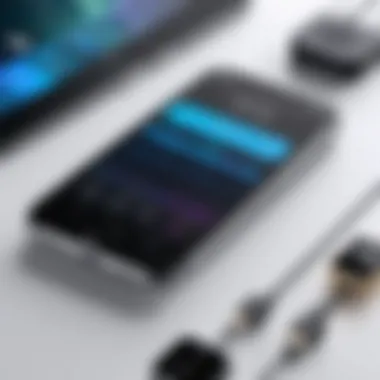Understanding iPhone Music Players: An In-Depth Exploration


Intro
The iPhone has been a significant player in the evolution of mobile music consumption since its inception. Understanding iPhone music players gives insights into how technology has transformed our relationship with music. The iPhone does not only function as a communication device; it has become an essential companion for many music lovers.
In this exploration, we focus on the features that set iPhone music players apart, examining their design, performance, and the software that supports them. Furthermore, we delve into the technical specifications that enhance usability and the integration with various music services, offering readers a comprehensive understanding of what to expect from the iPhone music experience.
This deep dive will illustrate how iPhone music players have not only kept pace with technological advancements but also influenced the way consumers engage with their favorite melodies and artists. Each section will unpack key elements, highlighting significant advancements and outlining the choices available to the user.
Key Features
Design and Build Quality
The design of the iPhone has undergone several transformations since the first model launched in 2007. Each iteration brings a refinement in aesthetics and functionality. The sleek aluminum body and glass panels not only provide a premium feel but also contribute to the overall sound experience. This construction can enhance audio quality, minimizing unwanted vibrations while listening to music.
Moreover, the ergonomic design allows for comfortable holding during extended listening sessions. Users appreciate the lightweight and portable form factor, making it easy to carry the device wherever they go.
Display and Performance
The display technology used in the iPhone has evolved with each release, contributing to an immersive music experience. With high-resolution Retina displays, users can interact with album artwork, playlists, and music visualizers in great detail. This enhances the overall aesthetic appeal, particularly for visually-oriented users.
Performance is another critical aspect. Processing power plays a significant role in how efficiently music applications run. The latest iPhones are equipped with powerful chips that support various music formats and streaming services without lag. This capability ensures smooth navigation through large libraries and easy access to cloud services.
"The integration of high performance and aesthetic design allows users to enjoy music, not just listen to it."
Product Specifications
Technical Specifications
When considering the iPhone as a music player, various technical specifications become relevant. Storage capacity, for instance, affects how many songs one can keep on the device. Current models come with various storage options, catering to different user needs.
Battery life is also an essential factor. iPhones are designed to provide long hours of playback, which is crucial for uninterrupted music enjoyment. Charging options, such as the ability to use fast charging, also enhance the user experience.
Compatibility and Connectivity
iPhones maintain strong compatibility with a variety of music streaming services such as Apple Music, Spotify, and Tidal. This versatility allows users to choose their preferred method of music consumption. Further, the seamless integration of Apple’s ecosystem, including AirPods and HomePod, enhances the listening experience. Connectivity options like Bluetooth and Wi-Fi enable easy streaming and sharing, allowing users to connect with other devices effortlessly.
Prelude to iPhone Music Players
The iPhone music player is a critical component of the modern mobile experience. Many users rely on their devices to access and enjoy music on the go. Understanding the evolution, features, and applications associated with iPhone music players improves the overall listening experience.
With the rise of digital music consumption, the iPhone has become a central hub for audio entertainment. This section provides insights on key elements like user interface, audio quality, and integration with other services. These aspects play vital role in how individuals connect with music.
As technology advances, so do the capabilities of iPhone music players. This article will highlight relevant information that showcases its significance in today’s tech landscape.
Historical Overview of Music Playback on Mobile Devices
The journey of music playback on mobile devices began well before the launch of the iPhone. Early devices like the first MP3 players captured listeners' attention, but they were limited in storage and functionality. The introduction of dedicated software such as iTunes in 2001 enabled users to digitize their music collections.
The arrival of smartphones brought significant changes. With increased storage and powerful processors, listening to music became more accessible. The iPhone, launched in 2007, revolutionized this space with its touch screen, an expansive library, and internet connectivity. Users were no longer confined to downloaded tracks but could stream vast catalogs from anywhere.
This historical progression sets the stage for understanding how the iPhone music player emerged as an industry leader.


The Role of iPhones in Revolutionizing Music Consumption
iPhones have significantly altered how users consume music. The integration of advanced hardware and seamless software created an intuitive music experience. Users easily access Apple Music, iTunes, and various streaming services with a touch.
The rise of iconic features such as voice commands through Siri allowed hands-free control. This capability transformed how users interact with their music libraries. Additionally, the integration of social media platforms enhanced music sharing, leading to enhanced user engagement.
"The iPhone did not just improve music playback; it created an ecosystem for music lovers, integrating technology with daily life."
From personal playlists to curated recommendations, the iPhone plays a crucial role in shaping listening habits today. Its influence is evident in various aspects of how consumers select and enjoy music.
Key Features of iPhone Music Players
The key features of iPhone music players play a crucial role in shaping the overall user experience. Music consumption is an integral part of daily life for many individuals, and the design and functionality of these players can greatly impact how users interact with their music libraries. Each element of these features contributes directly to enjoyment and convenience, making it essential to understand how they enhance listening experiences.
User Interface Design for Optimal Listening
The user interface (UI) of an iPhone music player is designed for efficiency and ease of use. Apple's focus on minimalism ensures that users can navigate their music collections with ease. The layout is intuitive, allowing users to find tracks, albums, or playlists quickly. Touch-based gestures simplify tasks like scrolling through song lists or adjusting volume levels.
Another notable aspect is the dark mode feature, which decreases eye strain while listening in low light. The color contrast in the UI is also carefully planned. This design helps in creating a distraction-free environment. Additionally, the ability to create playlists with drag-and-drop functionality further streamlines the process, allowing users to tailor their listening experience without hassle. Everything is geared towards making the listening experience pleasant.
Audio Quality and Playback Options
Audio quality in iPhone music players is one of the most critical features that impacts user satisfaction. Apple utilizes high-quality codecs, ensuring a clear and rich sound. Formats like AAC and ALAC provide excellent compression without significant loss in quality. This means even the smallest details in tracks are preserved, which is important for audiophiles.
Playback options are also quite diverse. Users can shuffle songs, repeat tracks, or even create smart playlists that automatically update based on listening habits. This adaptability allows iPhone users to enjoy their music in a way that matches their preferences. The integration of features such as lossless audio and spatial audio is worth noting, as these elevate the listening experience further by providing high-res audio and multi-dimensional sound.
Integration with Other Applications
The seamless integration of iPhone music players with other applications is a hallmark of Apple’s ecosystem. For example, Apple Music allows users to easily share songs or playlists on social media platforms like Facebook. The synergy among apps like Messages can also enhance music sharing capabilities.
Moreover, integrating with podcasts and audiobooks makes the iPhone a versatile media hub. Users can effortlessly switch between music, podcasts, or audiobooks without having to leave their preferred application. This removes unnecessary friction in user experience. Many third-party applications can also link to iPhone music libraries, expanding music discovery options.
In summary, these features highlight the thought process behind iPhone music players and emphasize their importance in today’s digital landscape. From user-friendly interfaces and high-quality audio options to robust app integrations, everything works together to create a compelling and cohesive user experience.
Exploring Music Applications on iPhone
The availability of music applications on the iPhone is crucial in shaping the listening experience. These applications offer more than just playback features; they provide access to a vast library of music, personalized playlists, and social sharing options. With the shift towards digital music consumption, the role of these apps has become even more prominent. They dictate how users discover and enjoy music in today’s fast-paced world.
Apple Music stands out as a primary service. However, the landscape is diverse, with various music applications competing for users' attention. Each app has unique capabilities and limitations, making it essential for users to understand their options. This knowledge allows consumers to choose what best suits their preferences, enhancing their interaction with music.
Apple Music: Features and Limitations
Apple Music is a central player in the music app ecosystem on iPhone. It offers a subscription-based service with access to over 75 million songs. One of its significant features is the personalized listening experience, where algorithms suggest music based on user behavior. The app also integrates seamlessly with Siri, enabling voice commands for hands-free operation.
However, there are limitations. For instance, users are required to maintain a subscription to access the entire music library, which may deter some. Connectivity can also be an issue in areas with poor signal, affecting playback quality. Additionally, some users report a learning curve in navigating the user interface effectively.
Comparative Analysis with Other Music Services
When comparing Apple Music with other services like Spotify or Tidal, notable differences emerge. \n- Spotify: Renowned for its free ad-supported tier. This option allows users to access music without committing to a paid plan. Spotify also excels in social sharing features, fostering community engagement among users.
- Tidal: Known for its superior audio quality, appealing to audiophiles. Tidal provides lossless and high-fidelity streaming options, making it attractive for those prioritizing sound quality.


This comparative analysis highlights that while Apple Music offers depth in library and features, other services provide alternatives that may resonate better with specific user needs.
Third-Party Music Apps: A Brief Overview
Beyond Apple Music and its competitors, a variety of third-party music apps enrich the iPhone's ecosystem. Some noteworthy examples include:
- Pandora: Focused on personalized radio stations, allowing for tailored listening experiences based on selected genres or artists.
- YouTube Music: Offers a comprehensive video and audio experience, integrating music videos into the listening process.
- SoundCloud: This platform is particularly valuable for discovering emerging artists and independent music not widely available on mainstream services.
These apps expand the choices available to users, catering to different tastes and listening habits. Understanding these options is essential for iPhone users aiming to maximize their music listening experience.
Hardware Specifications Impacting Music Playback
The hardware specifications of iPhones play a crucial role in their music playback capabilities, influencing both the sound quality and user experience. Understanding these specifications helps users make informed decisions and optimize their listening habits. Key components include the speaker systems, headphone output interfaces, and storage capacities. Each element contributes to how music is experienced on the device.
Speaker Quality Across iPhone Models
Speaker quality has improved significantly across various iPhone models. Apple has made advancements in audio performance to meet user demands for clearer, more robust sound. For instance, the introduction of stereo speakers starting from the iPhone 7 has allowed users to enjoy a more immersive audio experience. The placement of speakers also matters; front-facing speakers provide better sound projection, enhancing the overall enjoyment while watching videos or listening to music.
Many users notice that the sound quality can substantially vary among different models, such as between the iPhone 11 and iPhone 13. The latter has more refined speakers with improved bass response and clarity. This change impacts how music playback feels, showcasing the importance of selecting a model based on sound performance if listening to music is a priority.
"Sound is an emotional medium and the quality of speakers can profoundly impact the listening experience."
Headphone Output and Integration
Headphone output is another essential aspect of music playback on the iPhone. The shift from the traditional 3.5mm headphone jack to wireless audio integration has been a significant change. Users now often rely on Bluetooth technology for connectivity, which offers convenience but can present issues regarding audio latency and quality.
Apple's AirPods and AirPods Pro illustrate their commitment to providing a seamless audio experience. These devices feature advanced audio technology, such as spatial audio and active noise cancellation, fostering an enhanced listening environment. However, it’s necessary for users to consider that not all wireless headphones offer the same caliber of sound quality as wired ones. Compatibility with various headphone types can affect how music is delivered.
Storage Capacity Considerations for Music Libraries
Storage capacity plays a pivotal role when it comes to how much music a user can keep on their device. iPhones roundly offer various storage options, but these affect not only the overall amount of media but also the efficiency of playback. For those who prefer to store large libraries directly on their iPhone rather than relying solely on streaming, adequate storage is necessary.
Users should also be aware of how music formats can consume space. Lossless audio formats can provide enhanced sound quality but take up considerably more space compared to compressed formats like MP3. Choosing the right storage and managing the music library efficiently can enhance the overall music experience. Regular backups and cloud services such as Apple Music or iCloud can be useful for maintaining larger libraries without taxing the device’s storage.
User Experiences and Preferences
The exploration of user experiences and preferences is crucial in understanding the impact of iPhone music players on contemporary music consumption. By focusing on how individuals interact with music applications and playback options, we can gain insights into the varying elements that contribute to user satisfaction. Factors such as sound quality, user interface, and the ability to personalize settings play significant roles in determining how consumers engage with their music libraries. This section delves into three key aspects: hearing preferences and sound profiles, usage patterns and trends among users, and the influence of social sharing on music choices.
Hearing Preferences and Sound Profiles
Individuals possess distinct hearing preferences which affect how they perceive and enjoy music. The iPhone allows users to tailor their audio experience through various settings. For example, features like equalizers in Apple Music enable users to adjust frequencies to suit their tastes. Some may prefer bass-heavy sounds, while others might be inclined towards treble. This ability to customize audio settings greatly enhances the listening experience.
Moreover, the iPhone supports various audio formats, ensuring high fidelity in playback. Lossless audio and spatial audio capabilities provide users with immersive listening experiences. These advancements allow users to explore music in new ways. They can experience nuances in sound that they may have missed in compressed formats. In a world where sound quality is increasingly paramount, these features cater to audiophiles and casual users alike.
Usage Patterns and Trends Among Users
Understanding how consumers engage with their iPhones for music consumption is essential for assessing their preferences. Usage patterns reveal significant trends, such as the increase in streaming over traditional downloads. Services like Spotify and Apple Music have reshaped how users access their favorite tracks. A notable shift has occurred from owning music to accessing vast libraries on demand.
Data shows that users often engage with music in short bursts, influenced by the ease of accessing playlists and curated content. This behavior is reflected in the design of music applications. Curated playlists, such as "Made for You" on Apple Music, cater to this trend by providing personalized music selections, enticing users to discover new genres and artists.
The rise of music discovery tools has also transformed consumption patterns. Algorithms analyze listening habits, offering tailored recommendations, thus solidifying the role of technology in shaping musical tastes.


Impact of Social Sharing on Music Choices
Social media platforms have become significant channels for music discovery. On applications like Facebook and Reddit, users share their favorite tracks, albums, and playlists. This sharing creates a cycle where music becomes a communal experience rather than an isolated one. Seeing friends and influencers recommend a song can strongly influence an individual's music choice.
Moreover, social media interactions often lead to more profound discussions about music, fostering communities around specific genres and artists. Users may discover new music based on peer recommendations. This influence has made social sharing a pivotal aspect of modern music consumption.
The interconnectedness of social media and music apps shapes how users make choices and leads to diverse influences across musical tastes and preferences.
Future of iPhone Music Players
The future of iPhone music players is a topic of great importance because it reflects the ongoing evolution of music consumption in our digital age. As technology advances, so too do the features and capabilities of music players. This section aims to explore significant advancements, trends, and anticipated changes that can shape the experience of users in the coming years. By understanding these elements, consumers can better prepare for emerging options that will enhance their music-listening experiences.
Emerging Technologies in Music Playback
The emergence of new technologies plays a crucial role in the evolution of music playback on iPhones. Innovations such as artificial intelligence are beginning to change how users interact with music. For instance, AI-driven algorithms can personalize playlists based on listening habits. This ability allows for a customized experience that adapts to the user's taste over time.
Moreover, advancements in streaming quality, such as spatial audio and lossless formats, are becoming more prevalent. These technologies enable users to enjoy a more immersive listening experience. Users with compatible headphones or speakers can appreciate audio details that previous formats could not provide. Furthermore, improvements in battery life and device processing power make high-quality playback more accessible.
"The evolution of audio technology is reshaping how we experience music, making it more engaging and individualized."
Trends in Music Consumption Patterns
Consuming music today is vastly different from previous decades. As technology has developed, consumer preferences have shifted. One noticeable trend is the rise of streaming services, which provide access to extensive libraries at a monthly subscription. Users no longer need to own physical copies of music; they prefer the convenience of streaming on-the-go via apps like Apple Music.
Another trend is the integration of social media into music consumption. Platforms like Facebook and Instagram allow users to discover new music through friends’ recommendations or curated playlists. This affect how many people choose the songs they listen to.
Additionally, many listeners are gravitating towards podcasting. The format allows for a more varied audio experience beyond standard music tracks. As a result, music players will likely need to adapt in order to accommodate these changes and provide recommendations accordingly.
Anticipated Changes in Music Services Integration
Integration of various music services is essential for enhancing user experience. As competition in the music streaming industry intensifies, companies are exploring partnerships and collaborations. For example, one can expect iPhones to support more third-party services that provide unique content
Voice-activated assistants are also becoming commonplace. Users increasingly rely on Siri to manage their music libraries or control playback without touching their phones. Future iPhone models may improve these functionalities.
Moreover, the focus will expand beyond just music. Services may incorporate video, allowing users to watch music videos within their music apps seamlessly. This would create a more holistic audio-visual experience for consumers, catering to their diverse entertainment preferences.
In summary, the future of iPhone music players is set to evolve significantly. Emerging technologies, shifting trends in consumption, and changes in service integrations will shape a new landscape for users. Understanding these elements will guide consumers as they navigate enhancements in the digital music realm.
The End
The conclusion of this article emphasizes the significance of understanding iPhone music players in the evolving landscape of digital music consumption. With the advent of technological advancements, the way we listen to music has undergone a dramatic transformation. This section aims to tie together the insights gained throughout the article, presenting a clear picture of the current state of iPhone music players.
Summary of Insights on iPhone Music Players
iPhone music players have evolved not only in technology but also in how they shape user experiences. Key insights include:
- Integration of Services: iPhones seamlessly connect with various music services, enhancing accessibility. Services such as Apple Music integrate with user preferences and deliver personalized recommendations.
- Hardware Quality: The sound quality offered by different iPhone models has improved significantly. Features like better speakers and headphone output are critical for audiophiles.
- User Experience: Intuitive design and user interface play an essential role in music playback. Users favor apps that prioritize ease of use and accessibility.
This synthesis of insights underlines a well-rounded understanding of how iPhone music players function and their relevance in today’s consumer technology landscape.
Recommendations for Consumers
For consumers navigating the multitude of options available, several recommendations may enhance the listening experience. These recommendations include:
- Explore Third-Party Applications: While Apple Music offers extensive features, exploring alternatives can provide unique functionalities. Apps like Spotify or Tidal may cater to specific tastes or preferences.
- Invest in Quality Headphones: A good pair of headphones can make a significant difference in audio quality. High-fidelity options can elevate the overall listening experience.
- Stay Informed About Updates: Technology is ever-changing. Keeping up with software updates for music applications can maximize potential features and improvements.
In summary, understanding iPhone music players enables consumers to make informed choices about their music consumption. This article provides a comprehensive toolkit to navigate the features, services, and hardware of these devices. By following the insights and recommendations, consumers can enhance their musical experience significantly.



